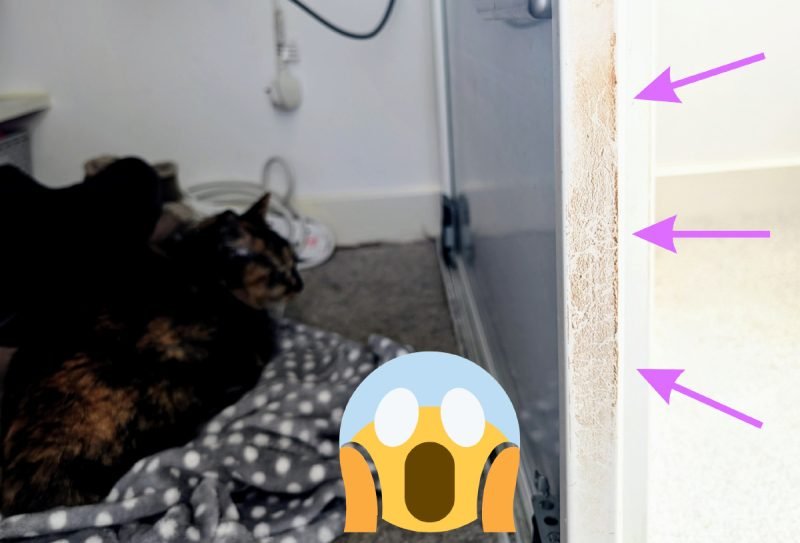
The post That’s Disgusting! My Cats’ Dirty Little Secret by Dr. Karyn Kanowski BVSc MRCVS (Veterinarian) appeared first on Catster. Copying over entire articles infringes on copyright laws. You may not be aware of it, but all of these articles were assigned, contracted and paid for, so they aren’t considered public domain. However, we appreciate that you like the article and would love it if you continued sharing just the first paragraph of an article, then linking out to the rest of the piece on Catster.com.
Hi, I’m Dr. Karyn! Read my introduction to learn more about me and meet my five hilarious cats: Clutch, Cyril, Alex, Zelda, and Zazzles.
Cats. Neat & tidy, delicate & demure, perfectly poised, pure, and pristine; they are the picture of cleanliness. But when you look a bit closer, you may start to see the dark, dirty, and greasy truth hidden beneath this seemingly flawless illusion.
I’m not talking about litter box etiquette or hairball habits, or even the mounds of fur that litter our hallways, infiltrate our wardrobes, and form blankets between our sofa cushions. These are just the well-known and largely inconsequential pitfalls of sharing your life with a cat. No, what I’m talking about is THIS:

The grease, the grime, the oily deposits that slowly build up over time, so insidious in nature that we only become aware of their presence when they, seemingly overnight, become a blinding scourge on the corners, edges, and hidden surfaces of our world. One day, you’re walking around the house as usual, doing some vacuuming here, a little dusting there, when you practically trip over an unsightly accumulation of filth that you would swear wasn’t there the day before. And yet, it was. It has been there for some time now, imperceptibly gaining ground day by day until it leaps forth from obscurity and forces you to acknowledge its existence. No longer content to live in the periphery, these greasy blemishes will make you doubt your cleaning abilities, your attention to detail, and your sanity.

Am I Overreacting?
Okay, maybe I’m being a little dramatic, but when you spend a significant amount of time each week cleaning up after five cats, five dogs, and one husband, it comes as a bit of a shock to realize these grubby little patches have been building up right under your nose, seemingly invisible until they were too large, too dark, and too ingrained in the plasterboard to miss.
The problem, as I see it, is threefold.
Firstly, I have fallen victim to the belief that my indoor cats are largely clean creatures, not capable of imparting grease and grime throughout my home.
Secondly, I tend to focus on floors and surfaces higher up when cleaning, forgetting to pay attention to things at cat height.
And finally, these marks do appear very gradually. If my cats were to actually wipe mud or dirt on the walls, doors, and cupboards, it would be noticed right away. Instead, this gradual accumulation is like the ill-fated frog, slowly boiling to death in a pot of water, heating up by such infinitesimal degrees that he doesn’t realize he’s cooking until it’s too late. Fortunately, the consequence in my scenario is a dirty wall, not a poached amphibian.

What Is It?
Ah! I thought you’d never ask. These unsightly smudges are not simply the result of dirt clinging to my deceptively clean felines, they are the result of scent marking. Pheromonal calling cards designed to make them feel at home, in much the same way we might spray some air freshener, light some scented candles, or set out flowers to create a pleasing olfactory experience.

Unlike the more adversarial tactics of urine spraying or territorial pooping, cats will often leave neutral or comforting pheromones behind by rubbing their face and head on surfaces in the areas they inhabit. With scent glands distributed around their whiskers, cheeks, forehead, and chin, whenever a cat rubs those zones on our doors, walls, and even us, they are leaving behind a few molecules that say “I like you and I feel safe and secure here.”
They choose edges to rub against as these tend to be more prominent points, and the corners allow them to apply more pressure to the glandular skin. Although the chemicals released by these glands do impart some territorial markers, they are not really possessive or designed to warn other cats off. They are also associated with feelings of comfort and calm, which is why cats seem to experience pleasure when they rub these areas against objects, people, and other cats.

Why So Grubby?
The secretions left behind each time a cat rubs their head against a doorframe are microscopic; you would never see them with the naked eye. But each time they push up against a spot, they leave tiny particles of dirt and dead skin cells along with the oily glandular material, and over time, these microscopic deposits build up, like the grubby marks that invariably appear around door frames and handles.
As you may have noticed with your own cats, most felines have favorite spots they like to rub against, and in my house, all five cats tend to use the same locations. So what starts out as an invisible chemical sticky note eventually becomes an oily, dirty billboard.
What Am I Going to Do?
It’s pretty simple; I’m going to pay a little more attention to these pheromonal hot spots when cleaning. BUT I am not going to use detergent, disinfectant, or any other chemical, enzymatic, or scented products here. These marks might be unsightly to me, but they are also very important to the serenity of my feline housemates. So when it comes to removing these grubby eyesores, it will be with water only – and you should do the same.

- Read her previous article: Emotional Support Tigers? Give Me a Break!
The post That’s Disgusting! My Cats’ Dirty Little Secret by Dr. Karyn Kanowski BVSc MRCVS (Veterinarian) appeared first on Catster. Copying over entire articles infringes on copyright laws. You may not be aware of it, but all of these articles were assigned, contracted and paid for, so they aren’t considered public domain. However, we appreciate that you like the article and would love it if you continued sharing just the first paragraph of an article, then linking out to the rest of the piece on Catster.com.


